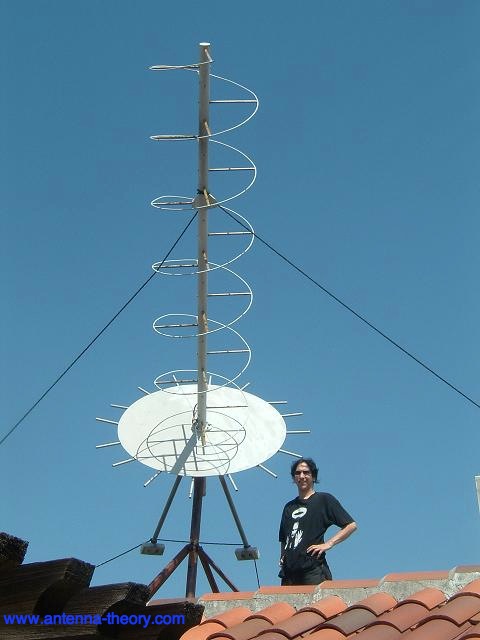Helical Antenna (Helix)
|
Helix antennas (also commonly called helical antennas)
have a very distinctive shape, as can be seen in the following picture.

The most popular helical antenna (helix) is a travelling wave antenna in the shape of a corkscrew that produces radiation along the axis of the helix antenna. These helix antennas are referred to as axial-mode helical antennas. The benefits of this helix antenna is it has a wide bandwidth, is easily constructed, has a real input impedance, and can produce circularly polarized fields. The basic geometry of the helix antenna shown in Figure 1.
 Figure 1. Geometry of Helical Antenna.
 - pitch angle, which controls how far the helix antenna grows in the z-direction per turn,
and is given by - pitch angle, which controls how far the helix antenna grows in the z-direction per turn,
and is given by 
The antenna in Figure 1 is a left handed helix antenna, because if you curl your fingers on your left hand around the helix your thumb would point up (also, the waves emitted from this helix antenna are Left Hand Circularly Polarized). If the helix antenna was wound the other way, it would be a right handed helical antenna. The radiation pattern will be maximum in the +z direction (along the helical axis in Figure 1). The design of helical antennas is primarily based on empirical results, and the fundamental equations will be presented here. Helix antennas of at least 3 turns will have close to circular polarization in the +z direction when the circumference C is close to a wavelength:

Once the circumference C is chosen, the inequalites above roughly determine the operating
bandwidth of the helix antenna. For instance, if C=19.68 inches (0.5 meters), then the highest
frequency of operation will be given by the smallest wavelength that fits into the above
equation, or
The helix antenna is a travelling wave antenna, which means the current travels along the antenna and the phase varies continuously. In addition, the input impedance is primarly real and can be approximated in Ohms by:

The helix antenna functions well for pitch angles ( The normalized radiation pattern for the E-field components are given by:
 For circular polarization, the orthogonal components of the E-field must be 90 degrees out of phase. This occurs in directions near the axis (z-axis in Figure 1) of the helix. The axial ratio for helix antennas decreases as the number of loops N is added, and can be approximated by:
 The gain of the helix antenna can be approximated by:
 In the above, c is the speed of light. Note that for a given helix geometry (specified in terms of C, S, N), the gain increases with frequency. For an N=10 turn helix, that has a 0.5 meter circumference as above, and an pitch angle of 13 degrees (giving S=0.13 meters), the gain is 8.3 (9.2 dB). For the same example helix antenna, the pattern is shown in Figure 2.
 Figure 2. Normalized radiation pattern for helical antenna (dB).

Antenna Tutorial (Home)
|
 =0.75C=0.375 meters, which corresponds
to a frequency of 800 MHz. The lowest frequency of operation will be given by the largest wavelength
that fits into the above equation, or
=0.75C=0.375 meters, which corresponds
to a frequency of 800 MHz. The lowest frequency of operation will be given by the largest wavelength
that fits into the above equation, or